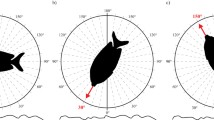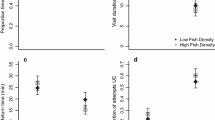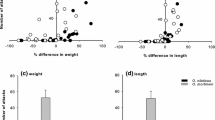Summary
In a shoal of four sticklebacks (Gasterosteus aculeatus) individual fish had partners with whom they repeatedly performed pairwise predator inspection visits. In six different trials, we found two reciprocal pairs per trial significantly more often than would be expected by chance. These results provide further evidence for a TIT FOR TAT like cooperation strategy in sticklebacks.
Similar content being viewed by others
References
Axelrod R (1984) The evolution of cooperation. Basic Books, New York
Axelrod R, Dion D (1988) The further evolution of cooperation. Science 242:1385–1390
Axelrod R, Hamilton WD (1981) The evolution of cooperation. Science 211:1390–1396
Boyd R (1989) Mistakes allow evolutionary stability in the repeated prisoner's dilemma game. J Theor Biol 136:47–56
Boyd R, Richerson PJ (1988) The evolution of reciprocity in sizable groups. J Theor Biol 132:337–356
Dugatkin LA (1988) Do guppies play tit for tat during predator inspection visits? Behav Ecol Sociobiol 23:395–399
Feldman MW, Thomas EAC (1987) Behavior-dependent contexts for repeated plays of the prisoner's dilemma II: dynamical aspects of the evolution of cooperation. J Theor Biol 128: 297–315
Fischer EA (1980) The relationship between mating system and simultaneous hermaphroditism in the coral reef fish, Hypoplectrus nigricans (Serranidae). Anim Behav 28: 620–633
Hamilton WD (1971) Geometry for the selfish herd. J Theor Biol 31:295–311
Licht T (1989) Discriminating between hungry and satiated predators: the response of guppies (Poecilia reticulate) from high and low predation sites. Ethology 82:238–243
Ligon JD, Ligon SH (1978) Communal breeding in the green wood-hoopoe as a case for reciprocity. Nature (London) 176:496–498
Lombardo MP (1985) Mutual restraint in tree swallows: a test of the TIT FOR TAT model of reciprocity. Science 227:1363–1365
Magurran AE, Girling SL (1986) Predator model recognition and response habituation in shoaling minnows. Anim Behav 34:510–518
Magurran AE, Higham A (1988) Information transfer across fish shoals under predator threat. Ethology 78:153–158
Magurran AE, Oulton WJ, Pitcher TJ (1985) Vigilant behaviour and shoal size in minnows. Z Tierpsychol 67:167–178
Magurran AE, Pitcher TJ (1987) Provenance, shoal size and the sociobiology of predator-evasion behaviour in minnow shoals. Proc R Soc London Ser B 229:439–465
May RM (1981) The evolution of cooperation. Nature (London) 292:291–292
May RM (1987) More evolution of cooperation. Nature (London) 327:15–17
Maynard Smith J (1982) Evolution and the theory of games. Cambridge University Press, Cambridge
Maynard Smith J (1983) Game theory and the evolution of cooperation. In: Bendall DS (ed) Evolution from molecules to men. Cambridge University Press, pp 445–456
Milinski M (1985) Risk of predation of parasitized sticklebacks (Gasterosteus aculeatus L.) under competition for food. Behaviour 93:203–216
Milinski M (1987) TIT FOR TAT in sticklebacks and the evolution of cooperation. Nature (London) 325:433–435
Milinski M, Külling D, Kettler R (1990) TIT FOR TAT: sticklebacks “trusting” a cooperating partner. Behav Ecol (in press)
Milinski M (1990) No alternative to TIT FOR TAT cooperation in sticklebacks. Anim Behav 39:989–991
Nowak M, Sigmund K (1989) Oscillations in the evolution of reciprocity. J Theor Biol 137:21–26
Packer C (1977) Reciprocal altruism in Papio anubis. Nature (London) 265:441–443
Packer C (1986) Whatever happened to reciprocal altruism? Trends Ecol Evol 1:142–143
Peck JR, Feldman MW (1986) The evolution of helping behavior in large randomly-mixed populations. Am Nat 127:209–221
Pitcher TJ, Green DA, Magurran AE (1986) Dicing with death: predator inspection behaviour in minnow shoals. J Fish Biol 28:438–448
Seyfarth RM, Cheney DL (1984) Grooming, alliances and reciprocal altruism in vervet monkeys. Nature (London) 308:541–543
Sokal RR, Rohlf FJ (1981) Biometry. Freeman, New York
Sullivan JF, Atchison GF (1978) Predator-prey behaviour of fathead minnows, Pimephales promelas, and largemouth bass, Micropterus salmoides, in a model ecosystem. J Fish Biol 13:249–253
Trivers RL (1971) The evolution of reciprocal altruism. Q Rev Biol 46:35–57
Turner GF, Pitcher TJ (1986) Attack abatement: a model for group protection by combined avoidance and dilution. Am Nat 228:228–240
Whitehead JM (1987) Vocally mediated reciprocity between neighouring groups of mantled howling monkeys, Alouatta palliata palliata. Anim Behav 35:1615–1627
Wilkinson GS (1984) Reciprocal food sharing in the vampire bat. Nature (London) 308:181–184
Author information
Authors and Affiliations
Additional information
Offprint requests to: M. Milinski
Rights and permissions
About this article
Cite this article
Milinski, M., Pfluger, D., Külling, D. et al. Do sticklebacks cooperate repeatedly in reciprocal pairs?. Behav Ecol Sociobiol 27, 17–21 (1990). https://doi.org/10.1007/BF00183308
Received:
Accepted:
Issue Date:
DOI: https://doi.org/10.1007/BF00183308




